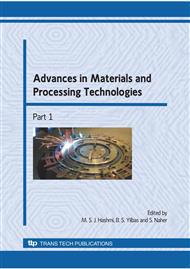p.7
p.16
p.24
p.31
p.36
p.41
p.49
p.56
p.67
Production of Nano Leaded Brass Alloy by Oxide Materials
Abstract:
Mechanochemical process was applied for brass alloy production using chemical grade oxide powders. Alpha brass was produced when CuO, ZnO and PbO were milled under argon atmosphere in the presence of graphite (as reducing agent). Concurrent reduction of zinc, copper and lead oxides took place in the argon atmosphere, whereas the reactions of the reduction did not proceed well in the closed chamber that filled with air. These reactions were promoted by milling time up to 100 hours. The amount of reduction tends to decrease for longer times.
Info:
Periodical:
Pages:
36-40
Citation:
Online since:
December 2009
Authors:
Price:
Сopyright:
© 2010 Trans Tech Publications Ltd. All Rights Reserved
Share:
Citation:


